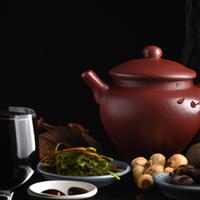
1 serving (15 grams) contains 9 calories, 0.0 grams of protein, 0.0 grams of fat, and 0.8 grams of carbohydrates.

Log this food in SnapCalorie

Nutrition Information
Calories |
134.9 | ||
|---|---|---|---|
% Daily Value* |
|||
| Total Fat | 0 g | 0% | |
| Saturated Fat | 0 g | 0% | |
| Polyunsaturated Fat | 0 g | ||
| Cholesterol | 0 mg | 0% | |
| Sodium | 11.8 mg | 0% | |
| Total Carbohydrates | 13.0 g | 4% | |
| Dietary Fiber | 0 g | 0% | |
| Sugars | 0 g | ||
| protein | 0.5 g | 1% | |
| Vitamin D | 0 mcg | 0% | |
| Calcium | 0 mg | 0% | |
| Iron | 0.5 mg | 2% | |
| Potassium | 23.7 mg | 0% | |
* Percent Daily Values are based on a 2,000 calorie diet. Your daily values may be higher or lower depending on your calorie needs.
Food Attributes
Source of Calories
About Shaoxing wine
Shaoxing wine is a traditional Chinese rice wine originating from the city of Shaoxing in Zhejiang province. Made from water, glutinous rice, wheat, and a fermentation starter, this amber-colored wine is renowned for its use in Chinese cooking, especially in marinades, braises, and stir-fries. While Shaoxing wine enhances the flavor profile of dishes, its typical alcohol content of around 10–16% limits its consumption as a drink. Nutritionally, it contributes minimal protein or vitamins but is high in carbohydrates due to its rice base. Its alcohol content means it should be consumed or used in moderation, as excessive intake can have negative health effects. In cooking, it is appreciated for its ability to tenderize meats and neutralize strong odors, providing a rich depth while using only small quantities, making its overall impact minimal when used properly in recipes.



